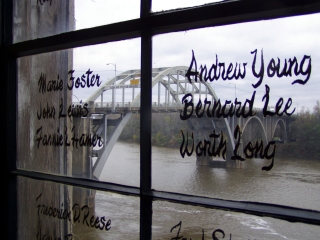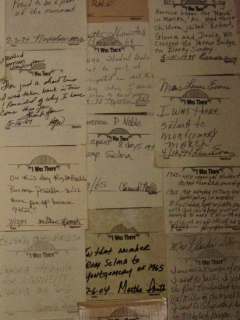Local Website; NPS Selma to Montgomery Historic Trail Website
WHAT IS IT?
A small Museum founded by Alabamans who faced the police and attack dogs on the Edmund Pettus Bridge on “Bloody Sunday” and later participated in the Selma-Montgomery march for freedom. The Site commemorates those fateful days in the Civil Rights struggle as well as honoring those who fought for universal suffrage as a whole.
SEE SCORES AND REVIEW (IN STORY FORMAT) BELOW:
 BEAUTY (4/10); HISTORICAL INTEREST (9/10); CROWDS (6/10);
BEAUTY (4/10); HISTORICAL INTEREST (9/10); CROWDS (6/10);EASE OF USE/ACCESS (3/5); BOOKSTORE (2/5); COSTS (2/5); RANGER/GUIDE TO TOURIST RATIO (3/5); TOURS/CLASSES (7/10); FUN (7/10); WOULD WE RECOMMEND? (9/10)
TOTAL 52/80
Selma, Alabama does not seem to have changed much since it became an indelible part of American history in March of 1965. The same old buildings downtown, the same wide streets, the same restaurants and the same Edmund Pettus Bridge. We arrived on a cold, rainy day much like it had been 40 years ago.
It is hard to separate Selma from its past. The National Voting Rights Museum is located downtown, along Water Street. We had last second thoughts about entering and spending the $5 fee. Not sure why but Michael felt almost fearful as if we were treading on sacred ground. We were at a place of American pilgrimage.
The Voting Museum did not exist until the early nineties when local citizens felt that something had to be done to honor the brave souls who faced the Alabama State Troopers and their attack dogs with non-violence, we have to remember the stories of those who marched 54 miles along U.S. Route 80 for the right to vote. Neither the National Park Service nor the State of Alabama had moved to remember the events of 1965.
Armed with ideas, determination and little money the Museum founders knew that unless they created the Site, nothing would ever happen. U.S. Route 80 would continue to be the Jefferson Davis Highway, the right to vote would further be taken for granted and the success and methods of non-violent protest would be lost. In an historical irony, the building that they procured for the Museum was, in the 60’s, a white supremacist group’s headquarters.
The founders’ dedication and labor has produced a personal, emotional and powerful Museum. Its aim is to honor not the Civil Rights Leaders, but the mass of people who participated in the Selma marches; the people who risked very tangible things – their life, property, possessions and probable jailing – for the right to participate in the American democracy.
 Hundreds, if not thousands, of standard sized Post-It notes adorn the wall opposite the Museum’s entranceway. Some notes contain short stories written in impossibly small words, some contain just names. The top of all the Post-It displays an image of the Pettus Bridge, with the words “I Was There”. All the Notes' messages have been created by everyday people who, in Selma, did extraordinarily brave things.
Hundreds, if not thousands, of standard sized Post-It notes adorn the wall opposite the Museum’s entranceway. Some notes contain short stories written in impossibly small words, some contain just names. The top of all the Post-It displays an image of the Pettus Bridge, with the words “I Was There”. All the Notes' messages have been created by everyday people who, in Selma, did extraordinarily brave things.The Museum’s other rooms all are distinguished by the same plucky grassroots feel. Gone is the polish of NPS Sites, the guarded language and centrist political feel. At the same time, the Voting Rights Museum’s exhibits lack comfortable sight lines, good lighting, easy visual pathways and the well-stocked bookstore. We wished that more videos had been available for viewing, especially the portion of the tremendous PBS documentary, Eyes on the Prize, regarding the Selma march. We understand that without funding, Museum’s are difficult to maintain.
But the Voting Rights Museum’s does an amazing job of personalizing the struggle’s participants. The exhibit room that recounts the events of March, 1965 displays stock pictures in a horizontal line around its walls. The images of police brutality that shocked and disturbed the world have not lost their power. The pictures of Martin Luther King, Jr. still inspire. In the middle of the room are footprint plaster casts of people who marched the distance to Montgomery. Small feet, large feet, children, grandmothers, men and women.
No more than 20,000 live in Selma, then and now. There was no anonymity in marching. If you chose to march, your boss, your neighbors, your in-laws knew. It was a brave and irrevocable choice. Those that marched as well as those that threw bricks and hurled insults at the marchers still live here today.
In 1996, the National Park Service finally saw fit to honor the road from Selma to Montgomery as a National Historic Trail. Funds were appropriated to create three Visitors Centers, one in Selma, one half-way along the Trail and one in Montgomery. In 2001, all funds were severely cut. To this day, no services exist. For their 200th anniversary, we have seen numerous Lewis and Clark National Historic Trail Visitors Centers pop up throughout the country. The March for Voting Rights’ 40th anniversary is coming up.
We live in a country that pays lip service to the principles of democracy while both historically and presently undercutting the sanctity of the “right to vote”. Having the ability to vote in a democracy is not a given. Participation has forever been a struggle, be it women’s suffrage, black suffrage or non land-owning suffrage. The fight is not over; it was not won in 1965. The elections of 2000 and 2004 only go to show that our system is imperfect and not everyone who has earned the right to participate can.
If we believe in democracy and believe in our system, we cannot deny people the right to vote through bullying lawsuits, imperfect voting machines and false lists of felony perpetrators. It matters little who benefits from these egregious errors. That is not the point. We must continue to hope for democracy. That is what the people gave their lives for in Selma. That is what the National Voting Rights Museum curators understand. They remember the past. They remember the illegal Poll Taxes, the intimidation, the dogs, the tear gas and their struggle. We cannot forget their disenfranchisement.
www.usa-c2c.com
© 2004-06